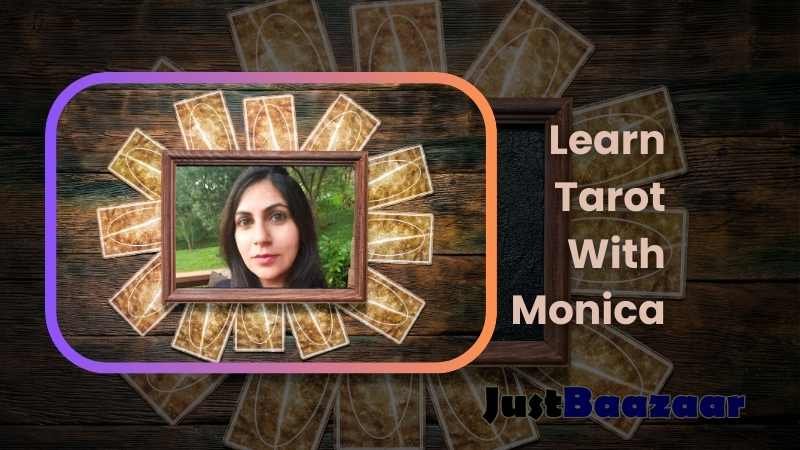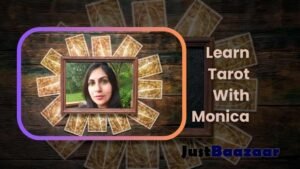Monica Mahtani, Founder Desi Tarot Hub – Leading Tarot Coach in India

CHAPTER 1: Introduction to Tarot Card Reading
In the mystical realm of divination, there exists a powerful tool that has been used for centuries to gain insights into the past, present, and future. This tool is none other than tarot card reading. In this chapter, we will explore the fascinating world of tarot card reading, understanding its importance and benefits along the way. So, let us delve into this enchanting journey with Monica Mahtani, Founder Desi Tarot Hub, a leading tarot coach in India.
Tarot card reading is an ancient method of tapping into the universal energies that surround us. By interpreting the symbols and messages depicted on each card of a tarot deck, one can gain profound insights into various aspects of life – love, career, spirituality, and more. It is a practice that allows individuals to connect with their intuition and higher consciousness.
Learning tarot card reading opens up endless possibilities for personal growth and self-discovery. The ability to decipher the messages hidden within each card empowers individuals to make informed decisions in their lives. Whether you are seeking guidance for yourself or helping others navigate their life’s journey, mastering tarot card reading can be truly transformative.
Now let’s meet Monica Mahtani, Founder Desi Tarot Hub – a seasoned tarot coach based in India who has dedicated her life to sharing her knowledge and expertise with others. With years of experience under her belt, Monica Mahtani, Founder Desi Tarot Hub has become renowned for her intuitive abilities and deep understanding of the cards.
Monica Mahtani, Founder Desi Tarot Hub believes that anyone can learn tarot card reading with dedication and practice. She firmly believes that every individual possesses an innate intuition waiting to be awakened. Through her guidance and expertise, she has helped countless individuals tap into their intuitive powers and develop strong connections with the cards.
As beginners embark on their journey towards becoming proficient in tarot card reading, it is crucial to understand the structure of a standard deck. A traditional deck consists of 78 cards divided into two main categories – major arcana cards and minor arcana cards.
The major arcana cards, also known as the “trump” cards, represent significant life events and archetypal energies. These 22 cards hold immense power and provide insights into the soul’s journey through life. Each card carries a unique meaning and symbolism, ranging from The Fool’s new beginnings to The World’s ultimate fulfillment.
On the other hand, the minor arcana cards consist of 56 cards divided into four suits – wands, cups, swords, and pentacles. These suits correspond to different elements – fire, water, air, and earth respectively. Each suit represents various aspects of daily life – passion (wands), emotions (cups), intellect (swords), and material wealth (pentacles). Understanding these suits is crucial for accurate interpretation during readings.
To truly master tarot card reading, one must learn how to interpret each card in relation to its position within a spread. There are various methods and spreads available for interpreting tarot cards; one popular example being the Celtic Cross spread. Monica Mahtani, Founder Desi Tarot Hub guides her students through each step of interpreting a card with precision and clarity.
In addition to learning technical skills, developing intuition is an integral part of becoming proficient in tarot card reading. Monica Mahtani, Founder Desi Tarot Hub emphasizes the importance of cultivating a strong connection with the deck through regular practice and meditation. By honing their intuition over time, tarot readers can unlock deeper insights from each card.
As we conclude this introductory chapter on tarot card reading with Monica Mahtani, Founder Desi Tarot Hub, it becomes evident that this ancient practice holds immense potential for growth and self-discovery. With dedication towards mastering the art of interpreting tarot cards combined with guidance from experienced coaches like Monica Mahtani, Founder Desi Tarot Hub, anyone can unlock their hidden potential as a masterful tarot reader.
In the chapters that follow in this book titled “Monica Mahtani, Founder Desi Tarot Hub – Leading Tarot Coach in India: Learn Tarot With Monica Mahtani, Founder Desi Tarot Hub and Become Master of Tarot Card Reading,” we will delve deeper into the intricacies of the tarot deck, explore advanced techniques, and learn how to apply this ancient wisdom to everyday life. So, join us on this transformative journey as we unlock the secrets of the tarot and embark on a path towards mastery.
Chapter 2: Understanding the Tarot Deck 
Introduction:
In the previous chapter, we were introduced to the fascinating world of tarot card reading and its importance in guiding individuals through life’s challenges and uncertainties. Now, it’s time to delve deeper into understanding the tarot deck itself. In this chapter, we will explore the 78 cards that make up a standard tarot deck, learn about the major and minor arcana cards, and discover the meanings associated with each suit.
Overview of the Tarot Deck:
A standard tarot deck consists of 78 cards which are divided into two main categories – the major arcana and the minor arcana. The major arcana comprises 22 cards while the minor arcana consists of 56 cards divided amongst four suits: wands, cups, swords, and pentacles.
The Major Arcana Cards:
Let’s begin our exploration with the major arcana cards. These represent powerful archetypal energies that influence our lives on a profound level. Each card in this category carries its own unique symbolism and significance.
For instance, The Fool signifies new beginnings, embracing risks, and trusting in one’s journey. The Magician represents harnessing one’s innate talents and manifesting dreams into reality. The High Priestess symbolizes intuition and spiritual wisdom while The Emperor embodies authority and structure.
Throughout this chapter, we will examine each major arcana card in detail to unlock their deeper meanings and how they relate to different aspects of life such as love, career, spirituality, or personal growth.
The Minor Arcana Cards:
Moving on to the minor arcana cards which are further divided into four suits – wands (fire), cups (water), swords (air), and pentacles (earth). Each suit represents different elements of daily living.
The wands suit is associated with passion, creativity, ambition, and action-taking. Cups represent emotions; they reflect matters related to love, relationships, and intuition. Swords embody the realm of thoughts, intellect, and decision-making. Lastly, pentacles signify material possessions, wealth, and practicality.
Within each suit, there are numbered cards from Ace to Ten along with four court cards – the Page, Knight, Queen, and King. Together they offer insights into various aspects of our lives and help us gain a deeper understanding of ourselves and the world around us.
In this chapter, we will explore the meanings associated with each minor arcana card in detail. We will also discuss how these cards can be practically applied in different situations such as making decisions or solving problems in daily life.
Connecting with the Tarot Deck:
Understanding the tarot deck is not just about memorizing card meanings but also about developing a personal connection with the cards. In this chapter, we will provide tips on how to develop your intuition while working with tarot cards.
Connecting deeply with your deck involves spending time familiarizing yourself with each card’s imagery and symbolism. By developing a personal relationship with your tarot deck through regular practice and meditation techniques specifically designed for tarot readers.
Additionally, we will explore different methods of interpreting tarot cards such as spreads like the Celtic Cross spread which provides a comprehensive overview of a situation or question posed to the reader. We will guide you step-by-step on how to interpret individual cards within a spread to gain valuable insights into any given situation.
Conclusion:
Understanding the tarot deck is an essential foundation for becoming a proficient tarot card reader. In this chapter, we delved into the 78-card structure of a standard tarot deck; learning about both major arcana cards which unlock life’s journey on a deeper level as well as minor arcana cards that provide insights into daily living.
By connecting intimately with your tarot deck through regular practice and deepening your understanding of each card’s symbolism within its respective suit contextually applying them to practical situations, you will be well on your way to becoming a masterful tarot card reader.
In the next chapter, we will explore the basics of interpreting tarot cards, providing you with valuable guidelines and techniques for extracting meaning from the cards in order to offer meaningful readings.
Chapter 3: Basics of Tarot Card Interpretation 
Tarot card reading is an intricate art that requires a deep understanding of the symbols and meanings behind each card. In this chapter, we will delve into the basics of tarot card interpretation, providing you with a step-by-step guide to unlock the insights hidden within the cards. We will also explore different methods and spreads for card interpretation, as well as provide you with tips on developing your intuition and connecting with the cards on a deeper level.
Interpreting a tarot card is like deciphering a secret language. Each card holds multiple layers of meaning, which can vary depending on its position in a spread and the context of the reading. To begin interpreting a tarot card, take a few moments to observe its imagery, colors, and symbols. Notice any emotions or impressions that arise within you as you gaze upon the card.
Step one in interpreting a tarot card is to consider its upright or reversed position. In its upright position, a tarot card generally represents positive aspects or energies associated with that particular archetype. However, when reversed, it may indicate challenges or blocked energies related to that archetype.
Step two involves examining the overall theme or message conveyed by the card. Each tarot suit (Wands, Cups, Swords, Pentacles) carries specific qualities and meanings. For instance, Wands represent creativity and passion; Cups symbolize emotions and relationships; Swords embody intellect and conflicts; while Pentacles signify material possessions and abundance.
Step three focuses on analyzing any additional symbols present in the card’s imagery. These symbols can provide further insights into specific areas of life or situations connected to the querent’s question or inquiry.
Once these initial steps are completed, we move on to step four: relating the individual interpretation back to the querent’s question or situation at hand. This is where intuition plays an essential role in connecting all aspects together cohesively.
To deepen your understanding of tarot card interpretation, it is crucial to explore different methods and spreads. One popular spread is the Celtic Cross spread, which consists of ten cards arranged in a specific pattern. Each card in the spread represents a different aspect of the querent’s life or question, allowing for a comprehensive analysis.
In addition to practicing different spreads, developing your intuition is vital for accurate and insightful tarot readings. Trusting your gut instincts and allowing yourself to connect with the cards on an intuitive level can enhance the depth and accuracy of your interpretations. Regular meditation and mindfulness exercises can help strengthen this connection.
Now that we have covered the basics of tarot card interpretation, let’s delve into some practical examples to illustrate how these principles come together in real-life readings.
Imagine a querent seeking guidance regarding their love life. Drawing the Ace of Cups could indicate new beginnings in relationships or emotional fulfillment. The Three of Swords might suggest heartbreak or emotional pain that needs healing. By combining these interpretations with other cards drawn in a spread, you can provide valuable insights into their love life journey.
Similarly, when interpreting career-related questions, drawing the Nine of Pentacles may signify financial stability or success through hard work and dedication. The Ten of Swords could indicate an ending or closure in one’s career path, leading to new opportunities for growth.
By understanding each card’s symbolism within its respective suit and relating it back to specific aspects of life such as love, career, or spirituality, you will be able to unlock profound insights during tarot readings.
As you embark on your journey as a tarot card reader, remember that practice is key. The more familiar you become with each card’s meanings and their interplay within various contexts, the more confident you will feel in providing accurate interpretations to those seeking guidance.
In our next chapter – “Major Arcana Cards: Unlocking Life’s Journey” – we will explore the 22 major arcana cards in detail and discover their significance in shaping one’s life path. Until then, continue practicing your tarot card interpretation skills and trust in your intuition as you connect with the wisdom of the cards.
Remember, with dedication and perseverance, you can become a master of tarot card reading and guide others on their spiritual journey.
Stay tuned for more insights from Monica Mahtani, Founder Desi Tarot Hub, the leading tarot coach in India, who will share her expertise to help you become a true master of tarot card reading.
CHAPTER 4: Major Arcana Cards: Unlocking Life’s Journey 
As we delve deeper into the world of tarot card reading, it is essential to understand the significance of the major arcana cards. These 22 cards represent the major milestones and transformative experiences that shape our lives. Each card has a unique energy and symbolism that can provide profound insights into various aspects of our existence.
Let us begin our exploration with the first major arcana card, The Fool. Depicted as a youthful figure standing at the edge of a cliff, The Fool represents new beginnings, innocence, and taking leaps of faith. When this card appears in a reading, it signifies an exciting journey or a fresh start in life. It encourages us to embrace uncertainty and trust our intuition as we embark on new adventures.
Moving on to The Magician, we encounter a figure standing before an altar adorned with symbols representing all four elements – earth, air, fire, and water. The Magician embodies manifestation and harnessing one’s inner power. This card reminds us that we have all the tools necessary to create our reality; it is up to us to tap into our potential and make things happen.
The High Priestess introduces us to intuition and the hidden realms of wisdom within ourselves. She sits between two pillars representing duality – light and darkness, conscious and subconscious mind. This card urges us to listen to our inner voice and trust our instincts when making decisions or seeking guidance.
With The Empress comes abundance, nurturing energy, and fertility. She represents creation in all its forms – from physical birth to creativity in art or business endeavors. When this card appears in a reading, it suggests that prosperity is within reach if we connect with nature’s cycles and embrace our nurturing side.
The Emperor symbolizes authority, structure, stability, and leadership qualities within ourselves or others around us. Just as he sits upon his throne with an air of confidence, The Emperor reminds us to take charge of our lives and establish a solid foundation for success.
Moving forward, we come across The Hierophant, representing tradition, spirituality, and the wisdom passed down through generations. This card encourages us to seek guidance from established belief systems or mentors who can provide valuable insight and support on our spiritual journey.
The Lovers card represents love, relationships, and choices. It depicts two figures standing beneath an angelic presence, symbolizing divine guidance in matters of the heart. When this card appears in a reading, it invites us to explore the depths of our emotions and make decisions based on love and harmony.
The Chariot signifies determination, willpower, and overcoming obstacles. Depicted as a warrior riding a chariot pulled by two sphinxes – one black and one white – this card reminds us that success comes through balance and aligning our inner forces towards a common goal.
Strength teaches us about resilience, courage, compassion, and taming our inner demons. In this card’s depiction, we see a figure gently restraining a lion with ease rather than brute force. It reminds us that true strength lies not in aggression but in finding harmony within ourselves.
The Hermit guides us towards introspection and self-reflection. This solitary figure holds up a lantern illuminating his path while surrounded by darkness. The Hermit urges us to seek answers within ourselves through meditation or solitude to find clarity on our life’s purpose.
Wheel of Fortune represents the cycles of life – both the ups and downs we experience along the way. Symbolized by a spinning wheel with various creatures depicted around its circumference, it reminds us that change is inevitable but also brings new opportunities for growth.
Justice embodies fairness, balance, truthfulness, and ethical decision-making. Depicted as a figure holding scales while blindfolded (representing impartiality), Justice encourages us to act with integrity in all aspects of life.
Next, we encounter The Hanged Man, symbolizing surrender, sacrifice, and a change in perspective. This card challenges us to let go of attachments or old patterns that no longer serve us and embrace a new way of thinking.
Death does not signify physical demise but rather transformation and rebirth. It represents the end of one phase and the beginning of another. The Death card reminds us that change is necessary for growth and urges us to release what no longer serves our highest good.
Temperance teaches us about moderation, patience, and finding balance in all areas of life. Depicted as an angel pouring water between two cups, this card reminds us to find harmony between our desires and practicality.
The Devil represents temptation, materialism, addictions, or unhealthy attachments that keep us chained to negative patterns. This card serves as a reminder for self-awareness and breaking free from limiting beliefs or toxic relationships.
The Tower is a powerful card signifying sudden upheaval or unexpected change in our lives. Depicted as a tower being struck by lightning with people falling from it, this card represents the destruction of old structures to make way for something new and transformative.
The Star brings hope, inspiration, healing energy, and renewed faith in the future. Symbolized by a woman pouring water into a pond under the night sky filled with stars; this card reminds us that even in dark times there is always light at the end of the tunnel.
Moving on to The Moon signifies intuition, dreams, illusions; it guides us through the realm of emotions and invites exploration into our subconscious mind. This card encourages us to trust our instincts even when faced with uncertainty or confusion.
The Sun radiates positivity, vitality, success; it illuminates all aspects of life with its warm glow. Just like its depiction – a bright sun shining over two children playing joyfully – The Sun signifies happiness after difficult times and encourages embracing life’s simple pleasures.
Judgment represents self-reflection, forgiveness, and the awakening of our true selves. This card shows figures rising from their graves as an angel blows a trumpet, symbolizing a call to rise above past mistakes and embrace personal growth.
Finally, we encounter The World card – the culmination of our journey through the major arcana. It signifies completion, fulfillment, and unity. Depicted as a figure dancing within a wreath surrounded by four creatures representing the elements; The World represents achieving harmony in all areas of life.
Each major arcana card holds immense wisdom and guidance for navigating the intricate tapestry of our lives. As you continue your tarot journey with Monica’s guidance, remember to approach these cards with an open heart and mind. Embrace their messages and insights to unlock the true potential within yourself.
In the next chapter, we will explore the minor arcana cards – offering practical insights into daily living that complement our understanding of the major arcana’s overarching themes.
Chapter 5 – Minor Arcana Cards: Insights into Daily Living 
Introduction:
In this chapter, we will delve into the fascinating world of the minor arcana cards and explore their profound meanings within each suit. As we continue our journey with Monica Mahtani, Founder Desi Tarot Hub, the leading tarot coach in India, we will gain valuable insights into how these cards can provide guidance and wisdom in our everyday lives.
Understanding the Minor Arcana:
The minor arcana consists of 56 cards divided into four suits: wands, cups, swords, and pentacles. Each suit represents different aspects of life and carries its own unique symbolism. Let’s take a closer look at each suit and its significance:
1. Wands:
The suit of wands is associated with passion, creativity, inspiration, and ambition. These cards often indicate opportunities for growth and advancement in various areas of life. For example, the Ace of Wands signifies new beginnings and creative potential, while the Ten of Wands represents taking on too many responsibilities or burdens.
2. Cups:
The suit of cups represents emotions, relationships, intuition, and spirituality. These cards reflect our deepest feelings and connections with others. The Two of Cups symbolizes love and harmony in relationships, while the Eight of Cups suggests a need for introspection or walking away from a situation that no longer serves us.
3. Swords:
The suit of swords deals with thoughts, intellect, communication, challenges, and conflicts. These cards often highlight mental clarity or struggles that require objective analysis to find resolutions. The Three of Swords signifies heartbreak or emotional pain while the Nine of Swords indicates anxiety or worry.
4. Pentacles:
The suit of pentacles is associated with material possessions, finances, stability, career success,and physical well-being.These cards reflect our practical concerns in life.The Fourof Pentacles symbolizes financial security or possessiveness whilethe Pageof Pentaclessignifies new opportunities or beginnings in the material realm.
Applying the Minor Arcana Cards:
Now that we understand the meanings behind each suit, let’s explore how we can apply these cards in practical situations:
1. Decision-Making:
When faced with important decisions, drawing a card from the minor arcana can offer valuable insights. For example, if you’re unsure about a career change, drawing the Five of Pentacles might indicate financial challenges that need to be considered before making a decision.
2. Problem-Solving:
If you’re facing challenges or obstacles in your life, consulting the minor arcana cards can provide guidance on finding solutions. For instance, drawing the Three of Swords might suggest that open communication is necessary to resolve conflicts within personal relationships.
3. Personal Growth:
The minor arcana cards also serve as powerful tools for self-reflection and personal growth. By examining our emotional patterns and thought processes through these cards, we can gain deeper insights into ourselves and make positive changes. For example, drawing the Seven of Cups may indicate a need to prioritize our desires and focus on what truly matters.
Remembering that each card carries multiple layers of interpretation allows us to explore their rich symbolism and apply them to our daily lives in meaningful ways.
Connecting with Monica’s Teachings:
As Monica Mahtani, Founder Desi Tarot Hub guides her students through their tarot journey in India, she emphasizes the importance of connecting with intuition while interpreting these cards. The minor arcana provides us with practical guidance while reminding us to trust our inner wisdom and instincts when seeking answers or making decisions.
Monica Mahtani, Founder Desi Tarot Hub encourages her students to practice daily tarot readings using the minor arcana cards as they navigate their everyday lives. By doing so, they develop a deep understanding of how these cards reflect their experiences and guide them towards personal growth and fulfillment.
Conclusion:
In this chapter on the minor arcana cards, we have explored their meanings within each suit and discovered how they offer invaluable insights into daily living. Whether it’s decision-making, problem-solving, or personal growth, the minor arcana cards provide us with a roadmap for navigating life’s challenges and embracing its joys. As we continue our journey alongside Monica Mahtani, Founder Desi Tarot Hub, we will uncover more advanced techniques in tarot card reading and further unlock the secrets of this mystical practice.
Chapter 6 – Advanced Tarot Techniques
In this chapter, we will explore the advanced techniques that can take your tarot card reading skills to the next level. These techniques will help you gain a deeper understanding of the cards and enhance your ability to provide insightful readings. By mastering these advanced techniques, you will become a true master of tarot card reading.
1. Reversals:
One of the most powerful tools in tarot card reading is the use of reversals. Reversals occur when a card appears upside down or in an inverted position. They add an extra layer of meaning and complexity to the interpretation. When a card is reversed, its energy may be blocked, delayed, or reversed altogether.
To interpret reversed cards, it is essential to consider both their upright and reversed meanings. The reversal may indicate obstacles, challenges, or internal conflicts related to the upright meaning of the card. For example, if you draw the reversed Tower card in a love reading, it could suggest a breakdown in communication or unresolved issues within a relationship.
2. Elemental Dignities:
Another advanced technique is using elemental dignities to analyze how different cards interact with each other based on their elemental associations (fire, water, air, earth). Understanding elemental dignities helps you see connections between cards and provides deeper insights into their combined meanings.
For example, if you have multiple fire cards (wands) in a spread related to career and creativity along with an air card (swords), it indicates that your creative ideas are being fueled by intellectual stimulation and mental clarity. On the other hand, if there are conflicting elements present in a spread like fire (wands) and water (cups), it suggests inner turmoil or conflicting desires that need resolution.
3. Timing with Tarot Cards:
Timing can be challenging when doing tarot readings since time is fluid within spiritual realms. However, there are methods to gain insight into timings using tarot cards. One such method is associating the suits with different time periods: wands represent weeks, cups represent months, swords represent days, and pentacles represent years.
By paying attention to the suits present in a reading and their positions within a spread, you can make educated guesses about timing. For instance, if you draw multiple wands and pentacles in a spread related to career advancement, it may suggest that significant changes will occur within a few years.
It’s important to remember that timing in tarot is not an exact science but rather a tool for gaining broader guidance on when events might unfold.
4. Exercises and Practice Activities:
To develop your advanced skills in tarot card reading, it is crucial to engage in regular practice exercises. These activities will help you deepen your connection with the cards and enhance your intuitive abilities.
One exercise involves drawing three cards daily and interpreting them based on different techniques discussed earlier – reversals, elemental dignities, or relating them to specific life areas like love or career. This exercise helps you become comfortable with applying advanced techniques in real-life scenarios.
Another effective practice activity is conducting readings for friends or clients who are open to receiving feedback. By offering readings regularly, you gain confidence in your abilities while also refining your interpretation skills.
Remember that practice makes perfect when it comes to tarot card reading!
As we conclude this chapter on advanced tarot techniques, remember that these methods require patience and dedication. It takes time to become proficient in using reversals effectively, understanding elemental dignities’ interplay between cards, and gaining insights into timing through the suits of the deck.
By incorporating these advanced techniques into your tarot card reading practice along with intuitive listening skills developed earlier chapters of this book, you will unlock new dimensions of wisdom within the cards. Your ability to provide profound readings will flourish as you continue on your journey towards becoming a master of tarot card reading.
Continue to practice and explore the depths of tarot, and you will soon find yourself offering guidance and insight to others with confidence and clarity.
Chapter 7 – Becoming a Master Tarot Card Reader 
As we journey through the mystical world of tarot card reading, we come to a point where our skills and knowledge have blossomed. In this chapter, we will explore what it takes to become a master tarot card reader. We will delve into the tips and tricks that will help you build a successful career as a professional tarot card reader, all while maintaining ethical standards.
Becoming a master in any field requires dedication and practice. Tarot card reading is no exception. It is essential to continue honing your skills by dedicating time to study and practice regularly. Treat each reading as an opportunity for growth and learning.
To become a successful professional tarot card reader, it is important to establish credibility and trust with your clients. One way to achieve this is through ongoing education and certification programs related to tarot card reading. By obtaining certifications from reputable organizations or attending workshops conducted by experienced professionals, you can enhance your knowledge base and gain recognition within the field.
Another crucial aspect of building your career as a professional tarot card reader is developing your own unique style or approach. While it is important to stay true to the traditional meanings of the cards, infusing your personal touch can make your readings stand out. Experiment with different spreads, techniques, or even incorporating other divination tools if they resonate with you.
Ethics play an integral role in any profession, especially in one that involves providing guidance and insight into people’s lives. As a master tarot card reader, it is vital to adhere strictly to ethical guidelines when offering readings to others. Always prioritize the well-being of your clients by maintaining confidentiality, respecting their boundaries, and refraining from making decisions on their behalf.
As you progress on your journey towards mastery in tarot card reading, consider joining professional associations or communities dedicated to promoting excellence within the industry. These communities provide opportunities for networking, sharing experiences, and accessing valuable resources that can further enhance your skills.
One of the most effective ways to demonstrate your expertise as a master tarot card reader is by offering readings to others. This can be done through personal consultations, workshops, or even online platforms. By consistently providing accurate and insightful readings, you will build a loyal client base and gain recognition within the tarot card reading community.
In addition to offering individual readings, consider organizing group sessions or hosting events where you can showcase your skills to a wider audience. This not only expands your reach but also allows you to connect with like-minded individuals who share a passion for tarot card reading.
Remember that the journey towards mastery is an ongoing process. Continuously seek feedback from your clients and peers, as their insights can help you improve and refine your reading techniques further. Embrace every opportunity for growth and learning, as it is through these experiences that we truly become masters of our craft.
Becoming a master tarot card reader requires dedication, practice, ongoing education, and adherence to ethical standards. By continuously honing your skills and developing your unique style, you can build a successful career in this mystical realm. Remember to always prioritize the well-being of your clients and stay true to the essence of tarot card reading. Embrace every step on this transformative journey as you unlock the secrets hidden within each card.
Continue on this path with confidence and passion because with Monica Mahtani, Founder Desi Tarot Hub – Leading Tarot Coach in India by your side guiding you throughout this journey of self-discovery through tarot cards – there’s no limit to what you can achieve!








